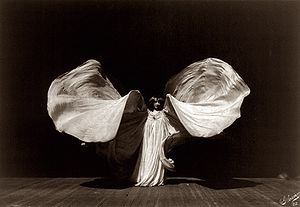Development
The new dance was originated by Loïe Fuller, who gave varying accounts of how she developed it. [1] By her own account, which is widely reported, having never danced professionally before, she accidentally discovered the effects of stage light cast from different angles on the gauze fabric of a costume she had hastily assembled for her performance in the play Quack M.D., and spontaneously developed the new form in response to the audience's enthusiastic reaction upon seeing the way her skirt appeared in the lights. [1] During the dance she held her long skirt in her hands, and waved it around, revealing her form inside. [1] In the words of the dance historian Jack Anderson, "The costume for her Serpentine Dance consisted of hundreds of yards of China silk which she let billow around her while lighting effects suggested that it was catching fire and taking shapes reminiscent of flowers, clouds, birds, and butterflies." [2]
By 1891, Fuller combined her choreography with silk costumes illuminated by multi-coloured lighting of her own design, and created the Serpentine Dance. [3] After much difficulty finding someone willing to produce her work when she was primarily known as an actress, she was finally hired to perform her piece between acts of a comedy entitled Uncle Celestine, and received rave reviews. [4]
"Soon, she (Loïe Fuller) auditioned for Rudolph Aronson of New York’s Casino Theatre. He named her dance “The Serpentine” and hired her to perform it as an entr’act in the comedy Uncle Celestin. Fuller achieved critical success with her Serpentine performances at the Casino and—when a dispute with Aronson forced her to switch venues—at the Madison Square Theatre. However, Fuller’s artistic achievements were soon dwarfed by legal troubles (among them, a copyright infringement suit against Minnie Renwood, the dancer Aronson hired to replace Fuller..." [5]

Almost immediately, she was replaced by imitators (originally Minnie "Renwood" Bemis). In the hope of receiving serious artistic recognition that she was not getting in America, Fuller left for Europe in June 1892.